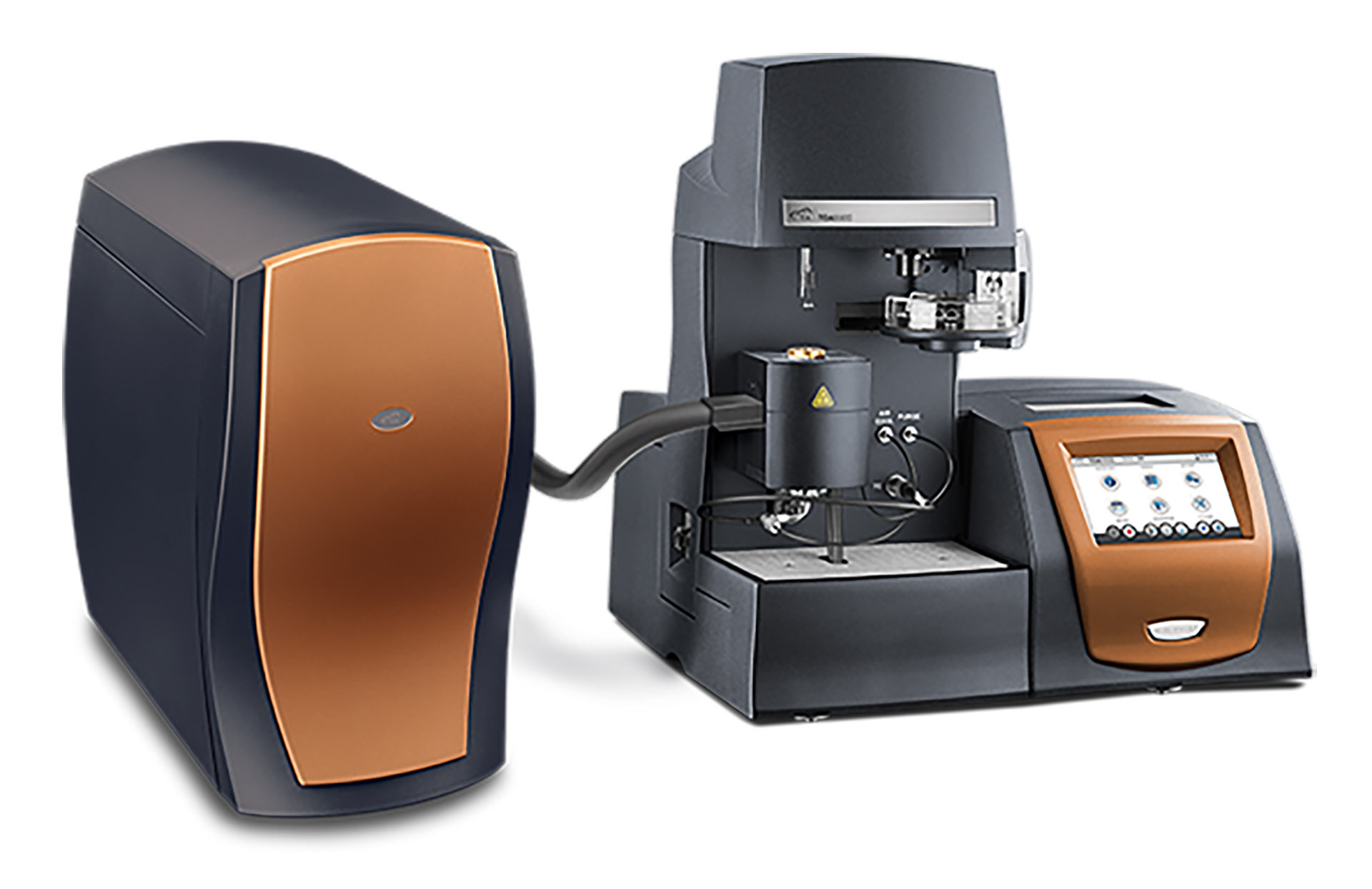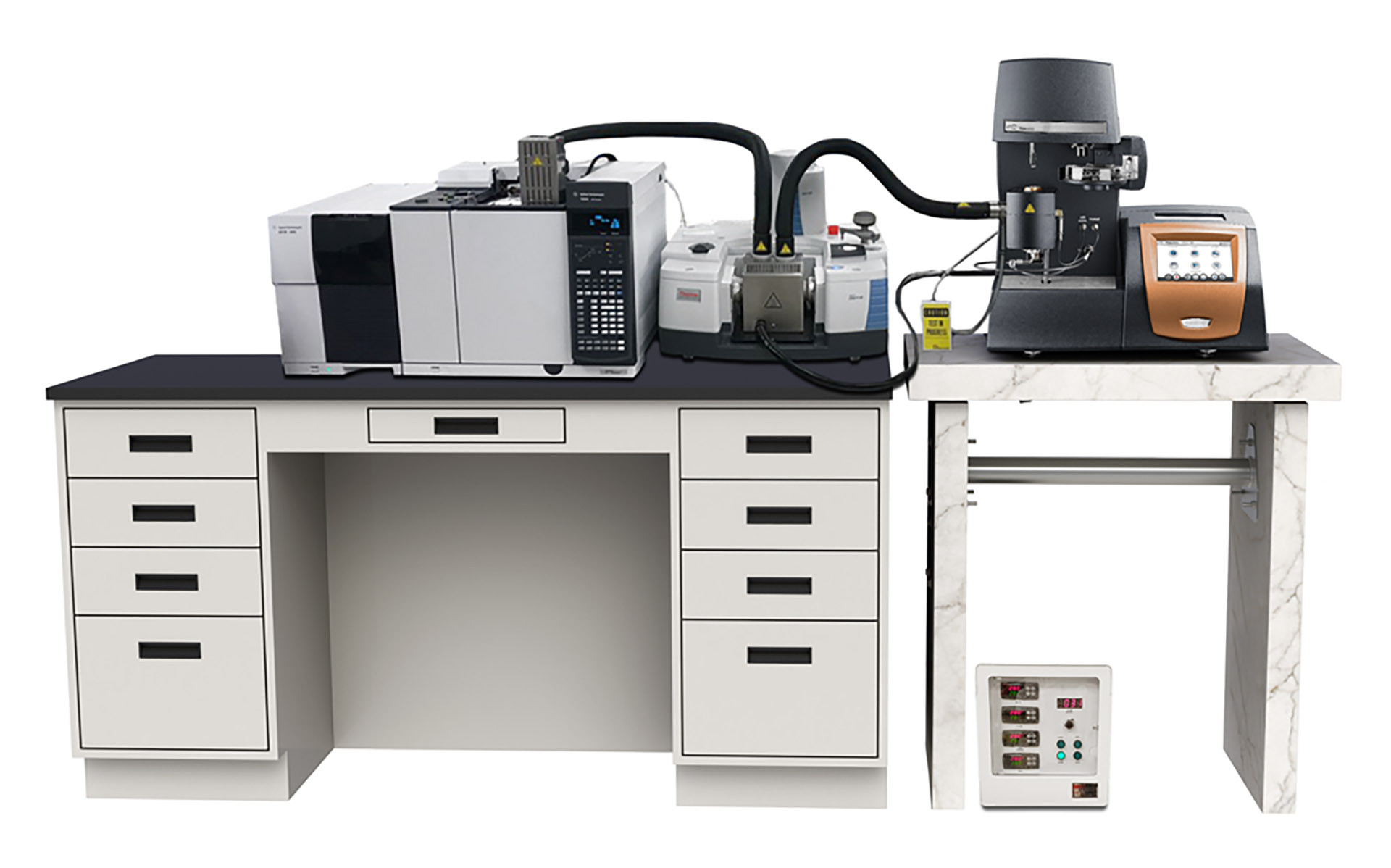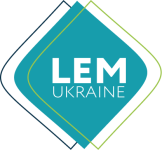Поширені види гіфенації ТГА
ТГА/ІЧФС
 Fourier Transform Infrared Spectroscopy, or FTIR, refers to a spectroscopic technique where a sample is irradiated with infrared radiation of a specific wavelength range. Depending upon the chemical nature of the sample being irradiated, some wavelengths will be absorbed, and some will not, thereby producing an absorption spectrum. These spectra are typically searchable in a library for the purpose of identification. The webinar linked to below gives an overview of the technique.
Fourier Transform Infrared Spectroscopy, or FTIR, refers to a spectroscopic technique where a sample is irradiated with infrared radiation of a specific wavelength range. Depending upon the chemical nature of the sample being irradiated, some wavelengths will be absorbed, and some will not, thereby producing an absorption spectrum. These spectra are typically searchable in a library for the purpose of identification. The webinar linked to below gives an overview of the technique.
Most benchtop instruments for TGA hyphenation are mid-IR instruments, meaning they operate over a wavenumber range of 40 to 4000 cm-1. In order for a molecule to absorb IR radiation, it must have an electric dipole moment. Therefore symmetric molecules, such as nitrogen or oxygen, will not be IR active.
ТГА/МС
 Mass spectrometry (MS) is an analytical technique whereby a gas is ionized and then undergoes fragmentation which can then be separated according to their mass-to-charge ratio and proportionally detected depending upon their abundance. For example, in a MS equipped with an electron ionization (EI source) incoming gaseous molecules interact with electrons in the 40 to 70 eV energy range generated by a heated filament which gives off electrons. The now ionized gaseous species are passed through a mass analyzer, whereby all but the chosen mass-to-charge species are allowed to pass through to the detector. The scanning mass analyzer (a quadrupole in the case of the Pfeiffer MS) continuously scans over the unit’s mass-to-charge range, typically 1-300 atomic mass units (amu) for benchtop instruments used in tandem with TGA, selectively allowing ions of different masses through to the detector over very short intervals of time. As the species impact the detector, they are counted based upon their abundance, thereby producing multiple spectra as the TGA scans in temperature.
Mass spectrometry (MS) is an analytical technique whereby a gas is ionized and then undergoes fragmentation which can then be separated according to their mass-to-charge ratio and proportionally detected depending upon their abundance. For example, in a MS equipped with an electron ionization (EI source) incoming gaseous molecules interact with electrons in the 40 to 70 eV energy range generated by a heated filament which gives off electrons. The now ionized gaseous species are passed through a mass analyzer, whereby all but the chosen mass-to-charge species are allowed to pass through to the detector. The scanning mass analyzer (a quadrupole in the case of the Pfeiffer MS) continuously scans over the unit’s mass-to-charge range, typically 1-300 atomic mass units (amu) for benchtop instruments used in tandem with TGA, selectively allowing ions of different masses through to the detector over very short intervals of time. As the species impact the detector, they are counted based upon their abundance, thereby producing multiple spectra as the TGA scans in temperature.
The technique is very sensitive – capable of detection limits in the ppb range, depending upon the gas being analyzed. The webinar linked below gives an overview of the technique.
ТГА/ГХ-МС
 Gas chromatography-mass spectrometry (GC-MS) refers to an analytical technique whereby the chemical components of a gas are separated by passing through a chemically activated column. The interior of the column is coated with a stationary phase and the gas components that pass through it show various affinities for this stationary phase. The more affinity the gas has for the stationary phase, the longer it will stay within the column. After passing through the column and being chemically separated, the gases are ionized and sent through a mass spectrometer for detection.
Gas chromatography-mass spectrometry (GC-MS) refers to an analytical technique whereby the chemical components of a gas are separated by passing through a chemically activated column. The interior of the column is coated with a stationary phase and the gas components that pass through it show various affinities for this stationary phase. The more affinity the gas has for the stationary phase, the longer it will stay within the column. After passing through the column and being chemically separated, the gases are ionized and sent through a mass spectrometer for detection.
When coupled with TGA, this technique will give the most chemical information of the techniques discussed. However, because of the time required for the gas to pass through the column, it is a non-continuous method as opposed to MS and FTIR which are continuous methods.
ТГА/ГХ-МС/ІЧФС
 Multiple hyphenation typically refers to TGA/FTIR/MS and TGA/FTIR/GC-MS setups. Hyphenating more than one analytical technique to a TGA allows for the maximum data from a single sample and greater flexibility in measurement capability. One can vary the number and type of analytical techniques utilized depending upon the experimental needs.
Multiple hyphenation typically refers to TGA/FTIR/MS and TGA/FTIR/GC-MS setups. Hyphenating more than one analytical technique to a TGA allows for the maximum data from a single sample and greater flexibility in measurement capability. One can vary the number and type of analytical techniques utilized depending upon the experimental needs.
Concerning TGA/FTIR/MS multiple hyphenation setup, since MS units typically do not require much gaseous sample (units draw about 1 sccm of gas through the capillary), the rest of the effluents exiting the TGA can be easily sent to an FTIR. Whereas when gas chromatography is introduced as in TGA/FTIR/GC-MS, dedicated hardware is required to ensure efficient flow of gas through the FTIR gas cell and into the GC-MS. Such hardware is also required for standalone TGA/GC-MS interfacing.


 Fourier Transform Infrared Spectroscopy, or FTIR, refers to a spectroscopic technique where a sample is irradiated with infrared radiation of a specific wavelength range. Depending upon the chemical nature of the sample being irradiated, some wavelengths will be absorbed, and some will not, thereby producing an absorption spectrum. These spectra are typically searchable in a library for the purpose of identification. The webinar linked to below gives an overview of the technique.
Fourier Transform Infrared Spectroscopy, or FTIR, refers to a spectroscopic technique where a sample is irradiated with infrared radiation of a specific wavelength range. Depending upon the chemical nature of the sample being irradiated, some wavelengths will be absorbed, and some will not, thereby producing an absorption spectrum. These spectra are typically searchable in a library for the purpose of identification. The webinar linked to below gives an overview of the technique. Mass spectrometry (MS) is an analytical technique whereby a gas is ionized and then undergoes fragmentation which can then be separated according to their mass-to-charge ratio and proportionally detected depending upon their abundance. For example, in a MS equipped with an electron ionization (EI source) incoming gaseous molecules interact with electrons in the 40 to 70 eV energy range generated by a heated filament which gives off electrons. The now ionized gaseous species are passed through a mass analyzer, whereby all but the chosen mass-to-charge species are allowed to pass through to the detector. The scanning mass analyzer (a quadrupole in the case of the Pfeiffer MS) continuously scans over the unit’s mass-to-charge range, typically 1-300 atomic mass units (amu) for benchtop instruments used in tandem with TGA, selectively allowing ions of different masses through to the detector over very short intervals of time. As the species impact the detector, they are counted based upon their abundance, thereby producing multiple spectra as the TGA scans in temperature.
Mass spectrometry (MS) is an analytical technique whereby a gas is ionized and then undergoes fragmentation which can then be separated according to their mass-to-charge ratio and proportionally detected depending upon their abundance. For example, in a MS equipped with an electron ionization (EI source) incoming gaseous molecules interact with electrons in the 40 to 70 eV energy range generated by a heated filament which gives off electrons. The now ionized gaseous species are passed through a mass analyzer, whereby all but the chosen mass-to-charge species are allowed to pass through to the detector. The scanning mass analyzer (a quadrupole in the case of the Pfeiffer MS) continuously scans over the unit’s mass-to-charge range, typically 1-300 atomic mass units (amu) for benchtop instruments used in tandem with TGA, selectively allowing ions of different masses through to the detector over very short intervals of time. As the species impact the detector, they are counted based upon their abundance, thereby producing multiple spectra as the TGA scans in temperature. Gas chromatography-mass spectrometry (GC-MS) refers to an analytical technique whereby the chemical components of a gas are separated by passing through a chemically activated column. The interior of the column is coated with a stationary phase and the gas components that pass through it show various affinities for this stationary phase. The more affinity the gas has for the stationary phase, the longer it will stay within the column. After passing through the column and being chemically separated, the gases are ionized and sent through a mass spectrometer for detection.
Gas chromatography-mass spectrometry (GC-MS) refers to an analytical technique whereby the chemical components of a gas are separated by passing through a chemically activated column. The interior of the column is coated with a stationary phase and the gas components that pass through it show various affinities for this stationary phase. The more affinity the gas has for the stationary phase, the longer it will stay within the column. After passing through the column and being chemically separated, the gases are ionized and sent through a mass spectrometer for detection. Multiple hyphenation typically refers to TGA/FTIR/MS and TGA/FTIR/GC-MS setups. Hyphenating more than one analytical technique to a TGA allows for the maximum data from a single sample and greater flexibility in measurement capability. One can vary the number and type of analytical techniques utilized depending upon the experimental needs.
Multiple hyphenation typically refers to TGA/FTIR/MS and TGA/FTIR/GC-MS setups. Hyphenating more than one analytical technique to a TGA allows for the maximum data from a single sample and greater flexibility in measurement capability. One can vary the number and type of analytical techniques utilized depending upon the experimental needs.